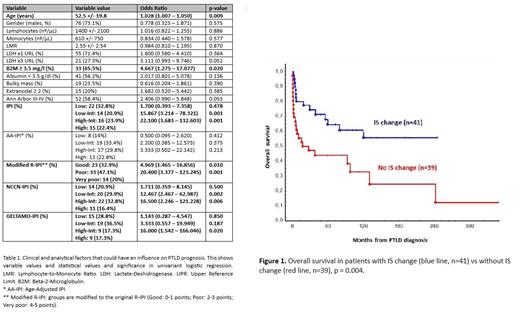Introduction: Post-transplant lymphoproliferative disorders (PTLD) are heterogenous lymphoproliferative disorders that develop because of immunosuppression in transplant recipients. Epstein-Barr Virus (EBV) infection is a major risk factor for the development of PTLD. Its management generally involves a reduction in immunosuppression and initial treatment with rituximab monotherapy (RM).
Aim: To present the epidemiology, management, and outcomes of PTLD in a large unicentric Spanish cohort of solid organ transplant (SOT) recipient who were transplanted over a 30-year period.
Methods: This is a retrospective study of 5797 SOT recipients who had their first transplant between 1992 and 2021 at Hospital Universitario 12 de Octubre. For each type of transplant, we calculated the incidence rate of PTLD. OS (Overall survival) was analyzed using the Kaplan-Meier model and the log-rank test Prognostic impact of the main clinical, analytical variables and prognostic indexes were analyzed.
Results: With a median follow-up of 16.4 years, 105 of 5797 SOT developed a monomorphic or Hodking-like PTLD (1.8%). The incidence was: 10% multivisceral transplantation (MVT), 2.8% heart, 2.3% liver, 2.2% lung, 1.4% kidney and 1.3% simultaneous kidney-pancreas (SPK). Median age at transplant was 48.3 (1-89) years. 12 were pediatric recipients' (1 lung, 1 kidney, 10 liver). 72% were men. Histochemical stains for Epstein-Barr virus (EBV) were performed in 75 of 105 diagnoses. EBER-positive histology was observed in the majority of patients (n = 44/77, 57%). Median time from transplantation to PTLD was 6.7 (0-16.4) years (21% in the 1st year post-transplant). In EBER-positive the onset was earlier (3.2 vs 9.2 years; p: .004) with 36% arising the 1st year post-transplant. 5-years cumulative incidence was 10% in MTV compared to 0.18%-1.6% in the rest. With a median follow-up of 6.9 years; median OS was 79.5 months, with no difference between type of organ transplanted, era of transplant, EBER histology or time from transplant to PTLD. Using logistic regression, age, beta-2-microglobulin (B2M), as well as the IPI, modified R-IPI, NCCN-IPI and GELTAMO-IPI prognostic indices were found to be significant prognostic factors for OS ( Table 1). Interestingly, the highest OS stratification was observed with the modified R-IPI, showing a median OS not reached in the low-risk group, versus 38 months at high risk and 3.2 months at very high risk (p<0.001). Immunosuppression (IS) was switched as the 1st therapeutic aptitude in 57% of the patients. Median OS was not reached in patients with IS switch (n=41) (plateau at 10 years; estimated OS 56%) vs. 15.3m for patients without IS switch (n=39) (P: .004) ( Figure 1). IS was reduced in 80%. It also reached OS impact (P: .05). There were 89 monomorphic patients who were treated as follows: RM (n=22), R-Chemotherapy (n=37), chemotherapy (n=6), no treatment (n=7), unknown (n=16). Of the 22 RM patients, 9 (41%) achieved complete remission (CR) with RM and required no further treatment. In the R-Chemotherapy (n=37) group (70% R-CHOP), 26 (70%) reached CR. There was no significant difference in OS between the two groups. 8/22 (36%) died in the RM group (2/22 (9%) due progressive disease (PD), 2/22 (9%) died pre-remission of non-PTLD causes and 4/37 (18%) died in remission of unrelated causes). In the R-Chemo group 8/37 (48%) patients dead (4/37 (10%) patients died of PD, 6/37 (16%) died pre-remission of non-PTLD causes and 8/37 (22%) died in remission of unrelated causes).
Conclusion: With this SOT cohort from a center with long experience we demonstrated an incidence of PTLD of 1.8%. EBV positive PTLD emerged sooner but OS was similar to those EBV negative. Stablished prognostic indices in DLBCL such as IPI, NCCN-IPI, and modified R-IPI were also applicable in PTLD. The modified R-IPI showed the best separation between the groups. Switch or reduction of the IS is an essential point to improve its prognosis. Our data suggest that first-line RM is an interesting option to consider. Strategies to tailor treatment with the least possible toxicity are necessary in these vulnerable patients. Additionally, our results suggest the utility of modified R-IPI in the clinical practice of PTLD and may serve as a basis for the development of specific prognostic models for this entity.
Disclosures
Grande:AbbVie: Other: Advisory Board. Martinez Lopez:Sanofi: Membership on an entity's Board of Directors or advisory committees, Other: Travel grants, Research Funding; BMS: Membership on an entity's Board of Directors or advisory committees, Other: Travel grants, Research Funding; Pfizer: Membership on an entity's Board of Directors or advisory committees, Other: Travel grants, Research Funding; Incyte: Membership on an entity's Board of Directors or advisory committees, Research Funding; Janssen: Membership on an entity's Board of Directors or advisory committees, Other: Travel grants, Research Funding.


This feature is available to Subscribers Only
Sign In or Create an Account Close Modal